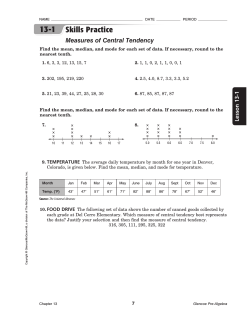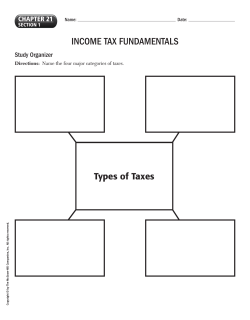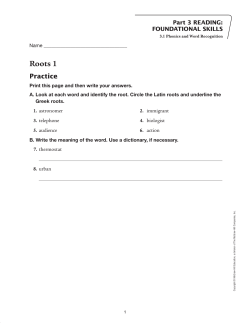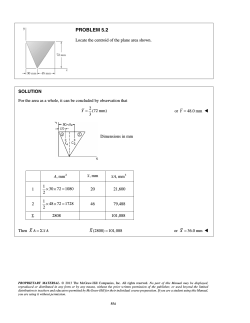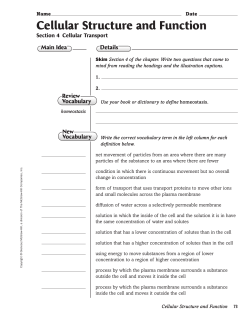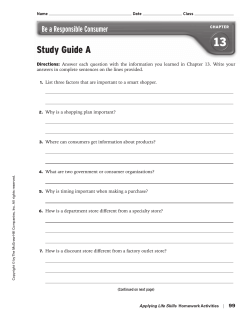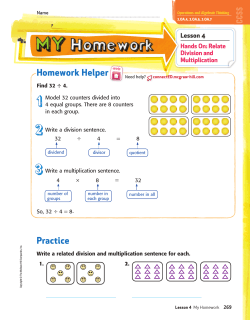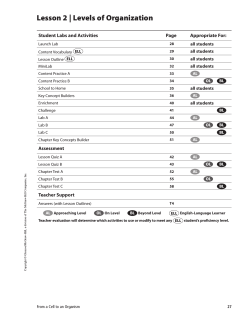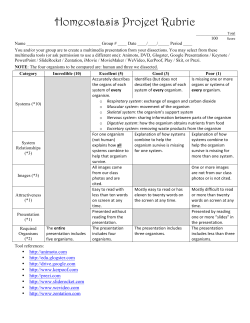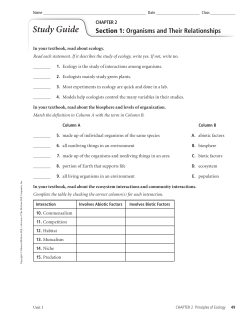
Lesson 1 | Characteristics of Life
Lesson 1 | Characteristics of Life Student Labs and Activities Page Appropriate For: Launch Lab 8 all students Content Vocabulary ELL 9 all students Lesson Outline ELL 10 all students MiniLab 12 all students Content Practice A 13 AL AL AL Content Practice B 14 AL OL BL School to Home 15 Key Concept Builders 16 Enrichment 20 Challenge 21 AL AL BL Lesson Quiz A 22 AL AL AL Lesson Quiz B 23 AL OL BL all students AL AL AL all students Assessment Teacher Support Answers (with Lesson Outlines) AL Approaching Level T2 OL On Level BL Beyond Level ELL English-Language Learner Copyright © Glencoe/McGraw-Hill, a division of The McGraw-Hill Companies, Inc. Teacher evaluation will determine which activities to use or modify to meet any ELL student’s proficiency level. Classifying and Exploring Life 7 Name Date Launch Lab Class LESSON 1: 15 minutes Is it alive? Living organisms have specific characteristics. Is a rock a living organism? Is a dog? What characteristics describe something that is living? Procedure 1. Read and complete a lab safety form. 2. Place three pieces of pasta in the bottom of a clear plastic cup. 4. Observe the contents of the cup for 5 minutes. Record your observations in the Data and Observations section below. 3. Add carbonated water to the cup until it is 2/3 full. Data and Observations 1. Think about living things. How do you know they are alive? 2. Which characteristics of life do you think you are observing in the cup? 3. 8 Key Concept Is the pasta alive? How do you know? Classifying and Exploring Life Copyright © Glencoe/McGraw-Hill, a division of The McGraw-Hill Companies, Inc. Think About This Name Date Content Vocabulary Class LESSON 1 Characteristics of Life Directions: Unscramble each word. Then write the correct term next to its definition on the lines provided. 1. clel 2. samigron 3. rainullclue 4. steamhissoo 5. cruelmalltiul 6. made of one cell 7. the ability to maintain steady internal conditions when Copyright © Glencoe/McGraw-Hill, a division of The McGraw-Hill Companies, Inc. outside conditions change 8. the smallest unit of life 9. made of more than one cell 10. a thing that has all the characteristics of life Classifying and Exploring Life 9 Name Date Class Lesson Outline LESSON 1 Characteristics of Life A. Characteristics of Life 1. All things are organized, grow and develop, reproduce, respond, maintain certain internal conditions, and use energy. 2. Things that have all the characteristics of life are called . B. Organization 1. Whether an organism is made of only one —the smallest unit of life—or many cells, all living things have structures that have specific functions. 2. Living things that are made of only one cell are called organisms. 3. Living things that are made of two or more cells are called organisms. 4. Living things with more than one cell have a greater level of because groups of cells function together. C. Growth and Development or increasing cell number. 2. The changes that occur in an organism during its lifetime are called . D. Reproduction 1. is the process by which one organism makes one or more new organisms. 2. Some organisms must have a(n) to reproduce, but others can reproduce without one. E. Responses to Stimuli 1. All living things can These changes are called external. 2. Hunger and thirst are examples of 3. Some examples of 10 to changes in the environment. and can be internal or stimuli. stimuli are light and temperature. Classifying and Exploring Life Copyright © Glencoe/McGraw-Hill, a division of The McGraw-Hill Companies, Inc. 1. Living things grow by increasing Name Date Class Lesson Outline continued F. Homeostasis 1. An organism’s ability to maintain steady internal conditions when outside conditions change is called . Maintaining these conditions ensures that cells can . 2. When your outside environment becomes too hot or too cold, your body responds by sweating, shivering, or changing the flow of maintain a body temperature of 37°C. to G. Energy 1. Cells continuously use to transport substances, make new cells, and perform chemical reactions. 2. For most organisms, the energy they use originally came to Earth from . Copyright © Glencoe/McGraw-Hill, a division of The McGraw-Hill Companies, Inc. the Classifying and Exploring Life 11 Name Date MiniLab Class LESSON 1: 20 minutes Did you blink? Like all living organisms, you respond to changes, or stimuli, in your environment. When you react to a stimulus without thinking, the response is known as a reflex. Let’s see what a reflex is like. Procedure 1. Read and complete a lab safety form. 2. Sit on a chair with your hands in your lap. 3. Have your partner gently toss a soft, foam ball at your face five times. Your partner will warn you when he or she is going to toss the ball. Record your responses in your Science Journal. 4. Have your partner gently toss the ball at your face five times without warning you. Record your responses. 5. Switch places with your partner, and repeat steps 3 and 4. Analyze and Conclude 1. Compare your responses when you were warned and when you were not warned. 3. 12 Key Concept Infer why organisms have reflex responses to some stimuli. Classifying and Exploring Life Copyright © Glencoe/McGraw-Hill, a division of The McGraw-Hill Companies, Inc. 2. Decide if any of your reactions were reflex responses, and explain your answer. Name Date Class Content Practice A LESSON 1 Characteristics of Life Directions: On the line before each definition, write the letter of the term that correctly matches it. Each term is used only once. 1. a tadpole changing into a frog A. growth and development 2. a bacterium dividing and becoming two bacteria B. homeostasis 3. eating because you feel hungry C. organization 4. your body temperature staying the same D. reproduction 5. what you need for doing all activities E. response to stimuli 6. groups of cells working together F. energy Directions: Circle the term in parentheses that correctly completes each sentence. 7. Something that has only four of the six characteristics of life is (a nonliving thing/an organism). Copyright © Glencoe/McGraw-Hill, a division of The McGraw-Hill Companies, Inc. 8. A living thing that is made of only one cell is a (multicellular/unicellular) organism. 9. Cells in a (multicellular/unicellular) organism usually are organized into groups that have different jobs. 10. Light and temperature are two examples of (external/internal) stimuli. 11. The smallest unit of life is a (cell/tadpole). 12. (Growth/Homeostasis) allows living things to keep a steady internal environment. Classifying and Exploring Life 13 Name Date Class Content Practice B LESSON 1 Characteristics of Life Directions: Complete the concept map by filling in each of the six characteristics of life. 1. 2. 6. 3. Characteristics of Life 5. 4. Directions: Answer each question on the lines provided. 7. How is the characteristic of organization in a unicellular organism different from 8. What is homeostasis? 9. What is the difference between internal stimuli and external stimuli? Give examples. 14 Classifying and Exploring Life Copyright © Glencoe/McGraw-Hill, a division of The McGraw-Hill Companies, Inc. organization in a multicellular organism? Name Date Class School to Home LESSON 1 Characteristics of Life Directions: Use your textbook to respond to each statement. 1. Research each organism listed in the table. Then give an example of how each organism exhibits the characteristic of life listed next to it. Copyright © Glencoe/McGraw-Hill, a division of The McGraw-Hill Companies, Inc. Organism Characteristic of Life Example Sunflower organization a. Tadpole growth and development b. Snake response to stimuli c. Oak tree use of energy d. 2. The ability to maintain a stable internal environment, or homeostasis, is another characteristic of life. Give three examples that illustrate how your body maintained homeostasis today. Classifying and Exploring Life 15 Name Date Key Concept Builder Class LESSON 1 Characteristics of Life Key Concept What characteristics do all living things share? Directions: Living things have all the characteristics of life. Unscramble the letters to find a characteristic of living things. Write the characteristic in the blank. 1. THOWGR DAN VELDEMEOPNT Hint: You have changed since you were born. 2. MEOHOSTSISA Hint: You sweat when you are hot. 3. IOGANORATNIZ Hint: You have different body parts that have different jobs. 4. PRORETIONDUC Hint: Baby birds are in a nest with their mother. 5. NSEPORES OT MULISTI Hint: You are hungry and go to the kitchen. 6. SUE FO ERGYEN Directions: Write your own hint for each of the six characteristics of living things on the lines provided. 7. Hint: 8. Hint: 9. Hint: 10. Hint: 11. Hint: 12. Hint: 16 Classifying and Exploring Life Copyright © Glencoe/McGraw-Hill, a division of The McGraw-Hill Companies, Inc. Hint: You have been playing soccer for an hour. Name Date Class Key Concept Builder LESSON 1 Characteristics of Life Key Concept What characteristics do all living things share? Directions: On each line, write the term from the word bank that correctly completes each sentence. Some terms may be used more than once. development energy growth organization reproduction stimulus homeostasis 1. Specialized structures in cells are an example of . 2. When a plant’s leaves and stems grow toward light, the plant is responding to an external . 3. A paramecium regulates by pumping water out of the cell. 4. Multicellular organisms have a greater level of than Copyright © Glencoe/McGraw-Hill, a division of The McGraw-Hill Companies, Inc. unicellular organisms have. 5. Increasing cell size is . 6. Changing from one kind of cell to a specialized cell is . 7. The process that makes more living things is . 8. All activities carried out by living things use . 9. Drinking water helps your body maintain Classifying and Exploring Life . 17 Name Date Class Key Concept Builder LESSON 1 Characteristics of Life Key Concept What characteristics do all living things share? The use of energy is an important characteristic that all living things share. Food webs describe how energy can pass from one organism to another. Directions: Answer each question or respond to each statement on the lines provided. 1. List the characteristics of life that plants and animals in a food web share. 2. Name three ways the organisms in a food web get energy. 4. What are some ways individual cells in an organism use energy? 5. What do you have in common with other living things in a food web? 18 Classifying and Exploring Life Copyright © Glencoe/McGraw-Hill, a division of The McGraw-Hill Companies, Inc. 3. What are some ways the organisms in a food web use energy? Name Date Class Key Concept Builder LESSON 1 Characteristics of Life Key Concept What characteristics do all living things share? All living things consist of cells. Some organisms are made of one cell. Other organisms are made of organized groups of cells. Directions: Read each sentence and decide which type of organism it describes. On the line before each item, write U for unicellular, M for multicellular, or B for both unicellular and multicellular. 1. These organisms are made of two or more cells. 2. Some of these organisms lay eggs. 3. These organisms grow as the number of cells increases. 4. These organisms use energy for everything they do. Copyright © Glencoe/McGraw-Hill, a division of The McGraw-Hill Companies, Inc. 5. During development, the cells in these organisms become specialized. 6. These organisms are made of only one cell. 7. These organisms respond to internal and external stimuli. 8. These organisms have specialized cells for reproduction. 9. This organism grows only as the cell increases in size. 10. Homeostasis is necessary for these organisms to survive. 11. These organisms reproduce by dividing and becoming two cells. Directions: Answer the question on the line provided. 12. What process is considered to be growth when it occurs in a multicellular organism and reproduction when it occurs in a unicellular organism? Classifying and Exploring Life 19 Name Date Enrichment Class LESSON 1 Tropism Living things share certain characteristics, one of which is the ability to respond to changes in the environment. These changes are called stimuli (singular, stimulus). Phototropism Like all living things, plants respond to stimuli. Light, for example, is a stimulus. Leaves and stems of plants often respond to light by moving toward the light source. Any movement of a plant toward or away from a stimulus is called a tropism. In the case of light, the movement of the plant is called phototropism. Charles Darwin and his son investigated phototropism in the late 1800s. They used five groups of seedlings in their experiments. The table summarizes their results. Based on their experiments, the Darwins concluded that something in the tip of a plant senses light and controls the movement of the leaves and stems toward the light source. Scientists later discovered that hormones produced in the tip of the stem are responsible for phototropism. The hormones cause different parts of the plant to grow at different rates. Other Tropisms Seedlings Setup Result tips covered with black caps did not grow toward the light Group 2 tips covered with transparent caps grew toward the light Group 3 tips cut off did not grow toward the light Group 4 stems covered with black tubes grew toward the light Group 5 tips and stems left uncovered grew toward the light Applying Critical-Thinking Skills Directions: Answer each question or respond to each statement. 1. Infer A plant’s movement away from a stimulus is called a negative tropism. What do you think scientists call a plant’s movement toward a stimulus? 2. Sketch a diagram showing the Darwins’ experiment. Include labels and captions in your diagram. 20 Classifying and Exploring Life Copyright © Glencoe/McGraw-Hill, a division of The McGraw-Hill Companies, Inc. Group 1 Hormones also cause plants to respond to other stimuli. For example, thigmotropism is a plant’s response to touch. Grapevines exhibit thigmotropism when they wrap around a wooden post. Geotropism is the movement of a plant in response to gravity. You can observe geotropism by placing germinating seeds and damp paper towels in a clear jar. After the roots have developed, set the jar on its side. In a day or two, the roots will turn and grow downward, exhibiting geotropism. The stem, however, will turn and grow upward. In this case, the stem is growing away from the force of gravity. This is known as negative geotropism. Name Challenge Date Class LESSON 1 Homeostasis Imagine you are a medical doctor who wants to study the ability of the human body to maintain homeostasis. You want to observe what happens to a person’s heart rate following exercise. Design an Investigation Copyright © Glencoe/McGraw-Hill, a division of The McGraw-Hill Companies, Inc. Design an investigation to find the answer to your question. You can use a volunteer to help you gather data. You also will need a stopwatch to find the volunteer’s pulse rate in three different situations—while resting, following exercise, and 5 minutes after exercise. Make a hypothesis about how the person’s heart rate will change during the experiment. Write each step of your experiment. How will you find the volunteer’s pulse? What exercise will the volunteer do? How many trials should you run? What safety measures should you take? How will you record your data? Afterward, create a line graph showing changes in the volunteer’s pulse rate. Include a brief explanation of why the pulse rate changed. Be sure to include the term homeostasis in your explanation. Classifying and Exploring Life 21
© Copyright 2025
